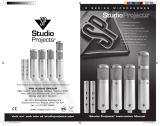Page is loading ...

PENCIL CONDENSER MIC PAIR
WITH INTERCHANGEABLE OMNI/
CARDIOID/SUPER CARDIOID CAPSULES
User Guide
Thank you for purchasing the LyxPro Large Diaphragm Cardioid Condenser Studio
Microphone. This User Guide is intended to provide you with guidelines to ensure that
operation of this product is safe and does not pose risk to the user. Any use that does not
conform to the guidelines described in this User Guide may void the limited warranty.
Please read all directions before using the product and retain this guide for reference. This product is intended for
household use only.
This product is covered by a limited one-year warranty. Coverage is subject to limits and exclusions. See warranty for details.
What’s in the Box?
Pencil condenser mics (2)
Omni polar pattern capsules (2)
Cardioid polar pattern capsules (2)
Super cardioid polar pattern capsules (2)
Windscreens (2)
2 tilting microphone clips (2)
Aluminum carrying case
IMPORTANT SAFEGUARDS
Please read all safety precautions and operating instructions before attempting to operate the unit. To reduce the risk of fire, electrical
shock, or injury, the following basic safety precautions should always be followed when using an electrical appliance.
SAFETY PRECAUTIONS
• Condenser microphones are extremely moisture-sensitive. Never use your microphone in close proximity to water or in extremely
humid conditions.
• Do not expose the microphone to extreme temperatures.
• Take care not to drop your microphone as this can lead to severe damage.
• After each use, wipe the microphone down with a soft cloth and place it back into its protective case.
• Do not attempt to alter or disassemble the microphone.
POWER SUPPLY
Phantom Power
This microphone requires phantom power to operate. Phantom power is DC current generated from pro audio equipment such as
mixers and pre-amplifiers, and requires the use of a balanced microphone cable: XLR-to-XLR or XLR-to-TRS. Always mute the sound
on your system before you switch on the phantom power supply.
Connecting to a Mixer or Computer
Computer:
To deliver audio directly to a computer, use a USB audio interface with an XLR microphone input that provides the required
phantom power.
Mixer:
When connecting to a mixer, use only balanced, microphone-level inputs with phantom power. Most mixers have a switch for
phantom power, so make sure phantom power is on for that channel.
USAGE
• Turn on your amplifier or mixing board and set the volume control to the minimum position.
• Connect the phantom power to the microphone.
• Adjust your volume.
• Do not cover the head of the microphone, position it too close to the speaker, or point it directly at the speaker.

POLAR PATTERNS
Omnidirectional
Omni means "all" or "every," hence the name for a mic that picks up sound evenly from all directions. Since they are equally sensitive to
sounds originating from all angles, omnidirectional microphones are very useful for capturing ambient noise. They are recommended
for situations where the mic must remain fixed while the sound source is moving, such as a lapel mic that captures a speaker's voice as
he moves about. The disadvantage is that an omni mic cannot be aimed away from undesired sources, such as PA speakers, which may
cause feedback.
Specications:
Element: Condenser
Polar pattern: Omni / cardioid / super cardioid
Frequency response: 30Hz-18 kHz
Sensitivity: -38dB ± 3dB (0dB=1V/Pa at 1 kHz)
Output impedance: 100 Ω ± 30% (at 1 kHz)
Self noise: 24dB A
Max. input SPL: 135db (at 1 kHz ≤1% THD)
SNR: 70dB
Power requirement: 9 – 52V phantom power
Customer Service:
info@lyxpro.com
866-849-3049
Cardioid
Cardioid microphones are most sensitive to sound coming from in front of the microphone, and also to a lesser extent from the sides.
Sound coming from behind the microphone will be greatly attenuated. This makes the cardioid polar pattern most suitable for
recording individual instruments or vocals within a group, and essential for miking a live performance.
www.lyxpro.com
Distributed by
C&A Marketing, Inc.
2 Bergen Turnpike
Ridgeeld Park, NJ 07660
MADE IN CHINA
LyxPro is a trademark of
C&A IP Holdings, LLC
©2015 All Rights Reserved
Omnidirectional
(at 1 kHz)
Cardioid
(at 1 kHz)
Super cardioid
Super cardioid microphones have a narrower area of sensitivity than cardioid mics, offering more side rejection and less rear rejection.
Because they pick up a small amount of sound from directly behind, it's important to place monitor speakers to the side facing the
"dead spots." Super cardioids are highly suited to very loud stage environments as they are very directional with high gain before
feedback. They're great for zeroing in on that perfect sweet spot for instruments, and are commonly used to mic drums and pianos.
For live recording sessions where isolation is important, super cardioid mics minimize signal bleed between a vocalist and his
own instrument.
Cardioid
(at 1 kHz)
/
